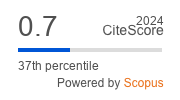Correlation of Concentrations of Certain Trace Elements in Normal and Diseased Human Tissues
Keywords:
Tissue trace elements, Zinc, CopperAbstract
Background Over the past decade there has been a growing awareness of, and interest in, the trace element concentration differences between normal and diseased tissues. Significant changes in tissue concentrations of Zinc (Zn) and Copper (Cu) have been previously reported in inflammation and cancer of certain human tissues.
Aim:(1)To correlate between Zn and Cu concentrations and the histological picture of normal and certain inflamed human tissues, namely the gall bladder (GB) the vermiform appendix (VA), visceral adipose tissue (VAT) and subcutaneous adipose tissue (SAT). (2) to detect whether there is a difference in the above-mentioned parameters between VAT and SAT. (3) to obtain recordings for trace element levels in human tissues.
Methods: Diseased GB (10), VA (10), VAT (10) near these organs and SAT (10) were removed by surgery. Tissues from these organs were then processed for histopathology and analyzed for trace elements concentration by Atomic Absorption Flame-Emission Spectrophotometer.
Results: Zn concentration was high in VAT (0.410 μg/g ± 0.181), GB (0.478 μg/g ±0.531) and VA (0.419 μg/g ±0.123) when compared to its level in SAT (0.1329 μg/g ± 0.0129) and the difference was significant (<0.007,<0.056 and <0.000 respectively).
Cu concentration was high in VAT (0.640 μg/g ± 0.150) and GB (0.919 μg/g ± 0.564) when compared to SAT (0.3893 μg/g ± 0.0130) and the difference was significant (<0.005 and <0.011 respectively). Cu concentration in the VA was low (0.2055 μg/g ±0.0654) and significantly different from all the other tissues (VA vs VAT <0.000, VA vs GB <0.002 and VA vs SAT <0.000).
The histology findings were typical of chronic inflammatory reactions in the GB and of acute inflammation in the VA.
Conclusions: The increase in tissue concentrations of Zn in VAT, GB & VA is due to inflammation.
The high Cu level in chronically inflamed GB and neighboring VAT is due to the increased need for this element during inflammation.
Our results, together with findings reported by others, allow us to think of using trace elements, namely Zn and Cu, as tools for diagnosis and treatment in appropriate conditions.













